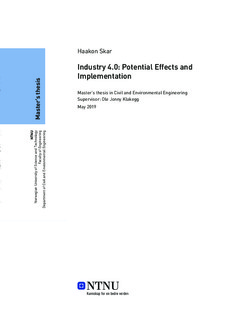| dc.contributor.advisor | Klakegg, Ole Jonny | |
| dc.contributor.author | Skar, Haakon | |
| dc.date.accessioned | 2019-11-01T15:02:37Z | |
| dc.date.available | 2019-11-01T15:02:37Z | |
| dc.date.issued | 2019 | |
| dc.identifier.uri | http://hdl.handle.net/11250/2626192 | |
| dc.description.abstract | Hensikt - Industrialisert byggeindustri møter stadig mer komplekse og krevende krav fra kunder. Innovative industrier som bilindustrien og mekaniske prosessindustrier har klart å integrere nye teknologier, som den industrialiserte byggeindustrien ikke har. For å forbedre logistikk innen industrialisert byggeindustri er undersøkelser, presentasjon av potensielle fordeler ved innovative teknologier og hvordan disse blir implementert presentert. Dette kan illustrere viktigheten ved implementering av ny teknologi og skape en holdningsendring i en ellers konservativ byggenæring.
Metode - Arbeidet er utført gjennom litteratursøk av eksisterende løsninger i industrialisert bygningslogistikk, nåværende "state of the art" samt intervjuer med pionerer innen bransjen. Litteratursøket har blitt gjennomført via søk med nøkkelord i anerkjente søkemotorer, som igjen ble filtrert gjennom inkluderingskriteria. Intervjuer ble gjennomført semi-strukturert, ansikt til ansikt og via telefon.
Mål og begrensinger - Fokuset i rapporten er på logistikk i en industrialisert bygningsprosess. Industrialisert bygging skiller seg fra "vanlig" bygging, ved å ta i bruk moderne systematiserte metoder ved design, produksjon, planlegging og kontrollering. Dette er også kjent som "Industry 4.0". Ni teknologier med potensiale for forbedring av logistikkprosessene innen industrialisert bygging ble funnet gjennom litteratursøk. De potensielle effektene og hvordan bevare disse gjennom en implementeringsprosess er grunnlaget for forskningsspørsmålene. Intervjuer har blitt gjennomført med representanter fra et norsk entreprenørfirma, Veidekke. Erfaringer og resultater som er presentert er tatt fra nylige prosjekter i Veidekke med et spesielt fokus på innovasjon.
Resultater og implikasjoner - Bruk av og fordeler ved sentrale teknologier inkludert BIM, "CloudComputing" og "Big Data" som allerede er etablert er presentert. "Additive Manufacturing", "Augmented Reality" og "Internet of Things" med liten grad av etablering, men stort potensiale er også blant annet inkludert. Teknologiene viser seg å være knyttet sammen, og samhandling mellom dem avgjørende for optimalisering av de illustrerte fordelene innovasjonene bringer. Nevnte teknologier har ulikt modningsnivå, noen er brukt daglig, andre påvirker bare bransjen. Industrialisert byggeindustri har ennå ikke omfavnet alle mulighetene og holdningsendringer sammen med investeringsstrategier må på plass for en videre utvikling. Uansett, er de største utfordringene knyttet til opplæring, kompetanse, samhandling, samarbeid og holdingsengringer. Den beste måten å implementer innovative teknologier virker å være utvikling av strategiske planer for implementering på lang sikt, inkludert nøye undersøkelser i evaluerings-, forbredelse- og beslutningsfaser. Flere publikasjoner og forskning med reelle effekter er referert som viktige faktorer for å få til en holdningsendring og transformasjon i byggenæringen. | |
| dc.description.abstract | Purpose - The industrialized construction industry is facing an ever evolving complexity and a growing customer demand. Innovative industries within the automotive and mechanical engineering sector have managed to integrate new technologies, whereas the industrialized construction industry to a lesser degree has succeeded with this. To enhance better performance for logistics in industrialized construction, a review of innovative technologies in the industry was conducted. A presentation of the potential benefitsand how the innovative technologies are implemented could illustrate the plus side of implementation, and create a change of mindset in the conservative construction industry.
Methodology - The research is conducted with literature reviews of material related to existing solutions in industrialized construction logistics, the current "state of the art" and practice, combined with interviews with industry pioneers. Information gathered in the literature review was obtained through key word searches in acknowledged search engines and filtered by inclusion criteria. Interviews have been done semi structured mostly face to face, but also on phone.
Scope and Limitations - The focus in this thesis is on enhancement of logistics within the industrialized
construction process. Industrialized construction is modern systemized methods of design, production, planning and control as well as mechanized and automated manufacturing, also known as Industry 4.0. Based on literature reviews, nine technologies with potential benefits for the logistic process in industrialized construction were selected. Potential of these nine innovative technologies and how to maintain the potential through an implementation processes is the basis for the research questions asked. Interviews have been conducted with representatives from a large Norwegian based construction firm, Veidekke. Experience and results are taken from recent projects with a special focus on innovation within Veidekke.
Results and Implications - Applications and benefits of central technologies already that have reached market maturity e.g. BIM, cloud computing and Big Data with as well as innovative technologies withlow market maturity and huge potential like e.g. Additive Manufacturing, AR and IoT are presented. The technologies are found to be interlinked, and a coherent application of the different tools instrumental to optimize the illustrated benefits that innovation brings. Moreover, these technologies have different maturity levels, some are used daily, while others just influence the industry too some degree. The industrialized construction industry has not yet fully embraced all of these opportunities, and a change in mindset and investment strategies must take place to further enhance the development. However, the main dependencies related to training, competence, investments, coherence, collaboration and mindset prevail. The best way to implement innovative technologies seems to be by development of a long-term strategic plan for implementation including a thorough investigation of evaluation, preparation and commitment phases. More publications and future research specific data of improvement are referred as important factors to change of mindsets in the industry for a commitment to transformation. | |
| dc.language | eng | |
| dc.publisher | NTNU | |
| dc.title | Industry 4.0: Potential Effects and Implementation | |
| dc.type | Master thesis | |
